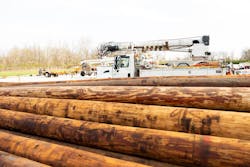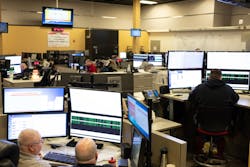Mobile Apps Save Grant Public Utility District Field Crews Time
In spite of the benefits automation brings, many utility and contractor crews still work with faxed service orders, handwritten notes, and paper maps to orchestrate field operations. Often, to clarify instructions or obtain the correct supplies, field workers make an extra trip (or more) each day back to the service yard or delay the project while waiting on a visit from a company representative. Other times, to bridge the gap in manual processes, line workers grab their personal mobile device to take a picture of a fax scrawled with handwritten comments or questions and text it to their operations center for a review, an input, or a decision. These manual processes spell added windshield time, potential errors, and delays.
Workflow automation
Automation, in part, means decentralizing work or moving chunks of manual tasks away from (or reducing involvement for) already heavily loaded employees like system operators, field supervisors, and others. Presently, many utilities and contractors have the technology to assign work automatically. But what's missing for many utilities is a means by which crews, dispatchers, and managers can launch and track multiple tasks automatically.
For starters, think about workflows. In doing research for this article, a logistics company's owner explained how valuable it would be to have a way to digitally track all his assets through a computerized workflow. Workflows are literally work (for example, repairing a crossarm or replacing a conductor) flowing from one stage through a co-worker or a tool to the next step in the process.
There are a variety of ways for utility service centers and field crews to tackle work. Some, like Grant County Public Utility District (PUD), have automated the tasks that would otherwise cause a crew extra time to complete a job. Grant PUD — a public utility district based and headquartered in Ephrata, Washington — wanted a system that would allow crews to identify and accept a job, complete it, and move on to the next work order easily, regardless of work location or weather conditions.
"In the dead of a winter's night, we don't want crews fumbling with gloves and a laptop to accept work," said Derin Bluhm, chief technology officer for Grant PUD.
With their ARCOS Mobile Workbench app, which Grant PUD installed last year, supervisors broadcast work to available field workers who are qualified, have the right equipment, and are able to perform the assignment. "Our crews poke their mobile device to accept the job via the app," Bluhm said. "They can then see the necessary tasks and even dictate notes."
It's easy to see how a utility or contractor would want to automate a workflow for tracking its assets along with automating timekeeping, basic invoicing, and tapping into a GIS to redline in-field updates the minute they happen. In fact, it's one way Grant PUD uses its mobile application. "Our Mobile Workbench gets crews to the trouble by visually routing them there; crews can make notes, capture time, and use the system to close out a ticket simply and efficiently," added Bluhm.
If all utilities could automate these manual steps in a crew's daily work on a single platform like Bluhm's, then line crews could easily eliminate at least one trip a day to the office, probably more. With automation including mobile apps on crews' personal devices, utilities could reduce error, increase efficiency, and save time.
Using mobile app for three-phase line extension
Here's how a fully automated platform could help a utility complete an overhead line extension with an underground pad mount for a new commercial business. Let's say the utility gets a request to install three-phase service to a new location, which is a strip mall. The new job requires not only extending the three-phase line for half a mile but also reconductoring a single-phase line to a three-phase line.
The utility's engineering organization (within the company or a contractor) would design the job with the automated platform using compatible units. Next, the utility would complete an agreement for service with the new customer and that paperwork would stream automatically back into the platform as part of the workflow, adding the target date for construction. The platform would then trigger a message about the pending project and fire off word to a field supervisor via the mobile app. They would review and assign the project to a native contractor and alert the supply chain about the upcoming work in case someone needs to order additional materials.
When ready to start construction, the native contractor's manager would tap the mobile app on their device, pick up the work order from the utility field supervisor, create a file requesting materials for the job, and electronically send that to their storeroom for filling. A contract field supervisor would then inspect the job site and assign a team to the job with the mobile app.
Once the contract field supervisor assigns a team, the corresponding crew members would see the engineering drawings, materials list, line design, and job specifications on their version of the mobile app. Concurrently, the storeroom staff would have the job location, start date, and materials in its workflow and deliver poles, supplies, and other parts to the worksite or a staging area.
The contractor team responsible for the overhead portion of the job would begin construction. Using its mobile app, each day, the team would log its time; the number of people on each crew engaged at the site; and the amount of progress made, while updating the GIS system.
Updates from the job would be seen by the operations center, field supervisors, GIS system managers, draftsmen, mapping specialists, or anyone with access to back-office systems. As it sees the field updates, the back-office team could accept or pause any additions to its job-site drawings. For example, if the overhead team extended the three-phase line by 10 poles on a certain day, the GIS system manager might want to immediately update the utility's maps to show the line energized up to the completed spans.
Real-time change order on the job
A mobile app platform like this would not only offer real-time updates but also speed up how crews overcome challenges in the field. For instance, if an overhead team working the new line extension realizes it cannot repurpose a pole as expected because of rot, it could redline the change with the mobile app and immediately send a message asking for additional material from the storeroom.
Along with the request, the app would note the additional time a contractor took to install a new pole and the utility's back-office would see the extra hours required for payment to the contractor team. As an overhead contractor completes their work, the underground team would install the pad mount transformer, and service and test-energize the transformer prior to energizing the customer.
The team would use the same mobile app to report its time and, if it added, for instance, an additional splice, it could redline that to alert the storeroom for material and note the time for billing purposes. Once the team completes the job, the leader would update the information on the mobile app to notify the utility's customer accounting department that the meter is spinning. The GIS team would get messages via the mobile app stating the line is fully energized and it should change any assets labelled "under construction" to "completed." The team's message via the mobile app that it has completed the job would also send the work order to the records department for closing.
One of the challenges of working from the field with technology of this kind is loss of an online connection. But that's a challenge a utility can hurdle with today's tools. According to Grant PUD, the Mobile Workbench now running there works online and offline to give workers and supervisors directions, information on an asset, and its real-time location, so crews don't have to pour over maps and printouts that may not reflect the reality on the field. Using the app via a smartphone, crews say they can accept available work, self-assign new work, or put a job in their queue.
Safety first
Increasing the speed with which crews complete a job makes sense if line workers and dispatchers can do that safely. Bluhm said Grant PUD's new mobile approach to work improves safety because, even without automatic vehicle location (AVL) data from a vehicle tracking system, a utility can see where crews are at any moment, making the app "a secondary source of crew location in an emergency situation." The utility industry's many and varied processes work. But fully automating these processes is an accelerant for crews to tackle work safely and more efficiently.
About the Author
Jim Nowak
Jim Nowak is senior director of operations, product, and services for ARCOS LLC. He retired as manager of emergency restoration planning for AEP in 2014. He was one of the original co-chairs for Edison Electric Institute's (EEI's) Mutual Assistance Committee and National Mutual Assistance Resource Team, a member of EEI's National Response Event (NRE) governance and exercise sub-committees, and capped his 37-year career with AEP by directing the utility's distribution emergency restoration plans for all seven of the company's operating units, spanning 11 states.


